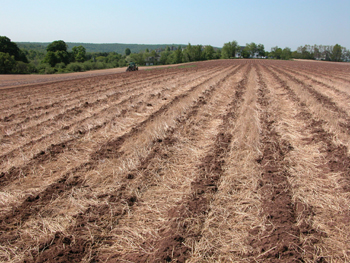Introduction
Tillage operations are generally conducted to prepare a seedbed, incorporate fertilizers, and cultivate for weed control. The number of trips required to perform these operations depends on soil type and condition, the crop, weather conditions, and the type of tillage system utilized. Excessive tillage operations increase fuel consumption, operating costs, machinery wear, and time and labor requirements. Too much tillage also increases soil compaction and releases carbon into the atmosphere.
Reducing the number of field operations
Farmers can reduce the fuel used in field operations by
- eliminating one or more tillage/field operations,
- substituting one type of tillage operation for another, and /or
- combining tillage operations into one pass over the field.
Reduced tillage systems
In recent years, production techniques and equipment have been developed for conservation tillage systems that have been adopted by many farmers. With proper management, overall yield averages for conventional and reduced tillage systems are nearly identical. For example, a recent study at the USDA’s Vegetable and Forage Crop Research Unit found no decline in veggetable yields with reduced tillage, as did a University of Arizona Cooperative Extension study on cotton. In moderately dry years, reduced tillage systems often produce yields higher than for conventional tillage systems. In wet years, conventional tillage systems may give higher yields.
Reduced tillage also takes less time, allowing for a second crop, or double cropping.
Continuous use of a reduced tillage system may not be appropriate for all soils. Periodic primary tillage on soils with a silty clay or silty clay loam texture may be necessary to control pests and reduce compaction.
In general, the diesel fuel requirements for a conventional tillage corn production system will be about 5 gallons per acre. Only about 2 gallons per acre are required for a no-till system, a savings of 60 percent.
Average fuel requirements for many of the operations commonly used in a corn production system are presented in the table below.
In addition to fuel savings with reduced tillage systems, substantial time savings and additional benefits can result. This will allow farming more acres with timely operations. Even if increased acreage is not anticipated, timely operations may increase yield and crop quality.
Alternative implements for similar operations
Often a lower fuel-requiring implement can be used to perform a similar operation. For example, a chisel plow may be used in place of a moldboard plow for primary tillage, or a spring or spike-tooth harrow may replace a disk or field cultivator under certain field conditions.
Tractors can be compared for fuel savings using easily available information. However, it is important to compare fuel savings with the investment cost for new equipment. There are various tools available for making those comparisons.
| field operation | gallons per acre |
| chopping stalks | 0.55 |
| moldboard plowing | 2.25 |
| disking | 0.74 |
| chisel plowing | 1.06 |
| knifing fertilizer | 0.60 |
| planting | 0.52 |
| rotary hoeing | 0.25 |
| cultivating | 0.43 |
| spraying | 0.23 |
| combining | 1.25 |
For row crop production, moldboard plowing requires about 2.2 gallons per acre and chisel plowing requires about 1.0 gallon per acre. For wheat and fallow practices, primarily because of reduced plowing depths, the diesel fuel requirements are about 1.4 and 0.6 gallons per acre for moldboard and chisel plowing respectively.
Combining field operations
Sometimes, field operations can be combined by connecting two or more implements. Combined operations reduce both fuel consumption, and time and labor requirements by eliminating at least one individual trip over the field. Light tillage, spraying, or fertilizing operations can be combined with either primary and secondary tillage or planting operations.
The amount of fuel saved depends on the operations combined. Generally, light tillage, spraying, and fertilizing operations consume between 0.25 and 0.50 gallon of diesel fuel per acre. Fuel savings of 0.12 to 0.33 gallon per acre can usually be expected from combining operations.
Eliminating one primary tillage operation and combining one light tillage, spraying, or fertilizing operation with another tillage or planting operation can usually save at least a gallon of diesel fuel per acre. Combining operations has the added benefit of reducing wheel traffic and compaction.
Additional Resources
Introduction to Energy Efficient Tractor and Field Operations
Tractor and Field Operations Energy Efficiency Checklist and Tips
Promoting Reduced Tillage in Vegetables. Cornell University. Includes information about equipment, case studies, trials, and other resources.
Contributors to this Article
Authors
- Zane Helsel, Extension Specialist in Ag Energy, Rutgers University
- Robert Grisso, Extension Engineer, Virginia Tech
- Vern Grubinger, Professor, University of Vermont Extension
Peer Reviewers
- Cole Gustafson, Biofuels Economist, North Dakota State University
- Carl Pederson, North Dakota State University

